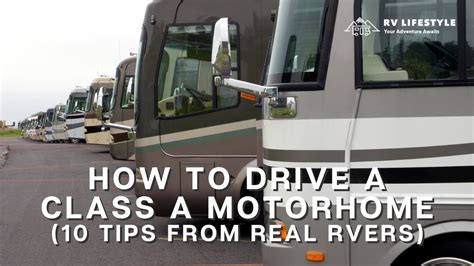How To Drive A Class A Motorhome
Ronan Farrow
Mar 24, 2025 · 3 min read

Table of Contents
How to Drive a Class A Motorhome: A Comprehensive Guide
Driving a Class A motorhome is a rewarding experience, offering unparalleled freedom and adventure. However, it's significantly different from driving a car or even a smaller RV. This guide provides a comprehensive overview of how to safely and confidently operate a Class A motorhome.
Understanding the Differences: Class A vs. Other Vehicles
Before we dive into the specifics, let's highlight the key differences between driving a Class A motorhome and other vehicles:
- Size and Weight: Class A motorhomes are large and heavy. Their length, height, and weight significantly impact maneuverability, braking distance, and fuel efficiency.
- Visibility: The sheer size can obstruct your view, requiring extra attention to blind spots and maneuvering in tight spaces.
- Turning Radius: Expect a much wider turning radius compared to cars or even smaller RVs. Wide turns are essential to avoid scraping the sides or hitting obstacles.
- Wind Resistance: The high profile makes them susceptible to crosswinds, demanding more control and careful planning, particularly on highways and open roads.
- Braking Distance: Longer braking distances are needed due to increased weight. Plan ahead and allow ample stopping distance.
Pre-Trip Checklist: Ensuring a Smooth Journey
Before hitting the road, a thorough pre-trip checklist is vital:
- Vehicle Inspection: Check tire pressure, fluids (engine oil, coolant, transmission fluid), and lights. Ensure all safety features are functioning correctly, including brakes, wipers, and mirrors.
- Weight Distribution: Proper weight distribution is crucial for stability and handling. Ensure cargo is evenly distributed, avoiding overloading the rear or front axles.
- Familiarization: Spend time getting used to the controls and dimensions of your motorhome. Practice maneuvering in an open area before embarking on a long journey.
- Navigation Planning: Plan your route carefully, considering road restrictions, bridge clearances, and potential hazards. Utilize GPS navigation specifically designed for RVs.
- Emergency Kit: Pack a comprehensive emergency kit, including roadside assistance information, a first-aid kit, and basic tools.
Driving Techniques: Mastering the Art of Motorhome Operation
Driving a Class A motorhome requires a different approach compared to driving a smaller vehicle. Here are some essential techniques:
- Smooth Acceleration and Braking: Avoid sudden acceleration and braking, which can lead to instability, especially in windy conditions.
- Wide Turns: Plan your turns well in advance, using a wider turning radius than you would with a car. Utilize your mirrors effectively.
- Blind Spot Awareness: Large blind spots are a significant concern. Use your mirrors frequently, and consider using extra side mirrors or a backup camera system.
- Defensive Driving: Maintain a safe following distance, anticipate the actions of other drivers, and be aware of your surroundings.
- Wind Management: Be extra cautious in windy conditions. Reduce speed and grip the steering wheel firmly to maintain control.
- Climbing Hills: Downshift appropriately when climbing hills to maintain momentum and avoid straining the engine.
Parking and Maneuvering: Precision and Patience
Parking and maneuvering a Class A motorhome requires practice and patience. Here are some helpful tips:
- Choose Spacious Parking Areas: Opt for larger parking areas to minimize the risk of damage or collisions.
- Use Spotters: When parking in tight spaces, consider using a spotter to guide you.
- Practice Makes Perfect: Practice maneuvering in an open area to build confidence and develop your skills.
- Backup Camera Systems: Consider installing a backup camera system for improved visibility when reversing.
Ongoing Maintenance: Ensuring Longevity and Safety
Regular maintenance is key to the longevity and safe operation of your Class A motorhome:
- Scheduled Maintenance: Adhere to the manufacturer's recommended maintenance schedule.
- Tire Rotation and Alignment: Regular tire rotation and wheel alignment are essential for optimal handling and tire life.
- Fluid Checks: Regularly check all fluids, including engine oil, coolant, transmission fluid, and brake fluid.
Driving a Class A motorhome is an enjoyable experience. With proper preparation, practice, and a commitment to safety, you'll be cruising the open road in no time. Remember, safety should always be your top priority.
Featured Posts
Also read the following articles
| Article Title | Date |
|---|---|
| How To Get Rid Of Sand In Pool | Mar 24, 2025 |
| How To Heal Your Life Book By Louise Hay | Mar 24, 2025 |
| How To Get Hard Water Spots Off Car Paint | Mar 24, 2025 |
| How To Cook A Peacock | Mar 24, 2025 |
| How To Get Free Youtube Music Premium | Mar 24, 2025 |
Latest Posts
-
How Do I Get To Bequia
Apr 04, 2025
-
How Do I Get The Alkalinity Down In My Pool
Apr 04, 2025
-
How Do I Get My Gun Back From Police
Apr 04, 2025
-
How Do I Get My Gas Certificate
Apr 04, 2025
-
How Do I Get My Ex Wife Back
Apr 04, 2025
Thank you for visiting our website which covers about How To Drive A Class A Motorhome . We hope the information provided has been useful to you. Feel free to contact us if you have any questions or need further assistance. See you next time and don't miss to bookmark.
